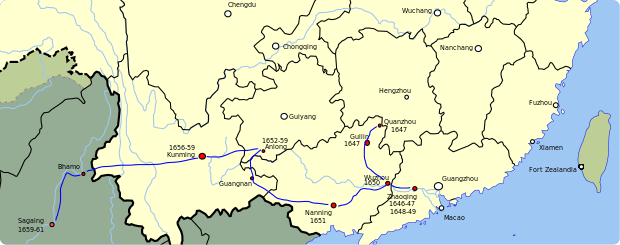Burmese–Siamese War (1662–64)
| Burmese–Siamese War (1662–1664) | |||||||||
|---|---|---|---|---|---|---|---|---|---|
| Part of Burmese–Siamese wars | |||||||||
| |||||||||
| Belligerents | |||||||||
| Toungoo Dynasty (Burma) |
| ||||||||
| Commanders and leaders | |||||||||
| Pye Min |
| ||||||||
| Units involved | |||||||||
|
Royal Burmese Army
|
| ||||||||
| Strength | |||||||||
| unknown | 90,000 | ||||||||
The Burmese–Siamese War (1662–1664) (Burmese: ယိုးဒယား-မြန်မာစစ် (၁၆၆၂-၁၆၆၄); Thai: สงครามพม่า-สยาม พ.ศ. ๒๒๐๕ or สงครามสยามรุกรานพม่าครั้งที่สอง, lit. "Second Siam invasion of Burma") was the war fought between the Toungoo Dynasty of Burma and the Ayutthaya Kingdom of Siam.
Background

In 1644, the army of the Manchus, a people from beyond the Great Wall, entered the Beijing capital city of Ming Dynasty and proclaimed the end of the Ming and the beginning of the Qing.[2] In the following two years, as the Qing extended their control over northern China, Zhu Youlang, the last emperor of the Southern Ming dynasty and the remaining Ming loyalists attempted to regroup in the south, In late January 1659, a Qing army led by Manchu prince Doni took the capital of Yunnan, sending the Yongli Emperor fleeing into nearby Burma, which was then ruled by King Pindale Min of the Toungoo dynasty.[3]
First invasion
In 1661 Pindale was overthrown by his chief general, Pye Min and Pye took the throne.
Fearing a possible weakening of influence in the northern vassal states following the successful the Ming Chinese invasion of Ava in 1660 to capture Zhu Youlang, King Narai mounted an expedition to bring Lan Na under the direct control of Ayutthya kingdom. Although the expedition was successful in taking control of Lampang and other smaller cities. In March 1662 he got Martaban to switch sides, and occupied upper Tenasserim coast. Fortunately for the Burmese, their troubles with the Ming were over. Their land and naval units recaptured Martaban and Tavoy by December 1662. They followed up on the retreating Siamese but were driven back near Kanchanaburi with heavy losses.[4][5]
Second invasion
A second expedition had to be conducted to bring Lan Na under control again. The Siamese army invaded Chiang Mai, catching the Burmese command completely off guard. The Siamese captured Chiang Mai on 10 February 1663, and drove back Burmese forces that arrived belatedly at Sai Yok. In November 1663, the Siamese then led an army of 60,000 in an invasion of Burma, capturing Martaban, Moulmein, Syriam, Rangoon, Pegu, and then laid siege to Pagan in 1664. Burmese defences withstood several Siamese onslaughts until May 1664 before the rainy season arrived, after "causing many casualties in dead and wounded and capturing many prisoners of war", the Siamese retreated.[1]:220–239
Meanwhile, the Siamese garrison at Chiang Mai was holed up in a deserted city, and its troops were constantly ambushed by resistance forces whenever they ventured out of the city. In late November 1664, the Siamese evacuated Chiang Mai, and returned.[6]
Aftermath
This was the last major war between the two kingdoms until 1760 although they traded small raids in 1675–1676, and in 1700–1701.
See also
Notes
References
- Royal Historical Commission of Burma (1832). Hmannan Yazawin (in Burmese). 3 (2003 ed.). Yangon: Ministry of Information, Myanmar.
- Phayre, Lt. Gen. Sir Arthur P. (1883). History of Burma (1967 ed.). London: Susil Gupta.
- Rajanubhab, Damrong (2001). Our Wars With the Burmese. Bangkok,Thailand: White Lotus. ISBN 9747534584.
- Harvey, G. E. (1925). History of Burma: From the Earliest Times to 10 March 1824. London: Frank Cass & Co. Ltd.